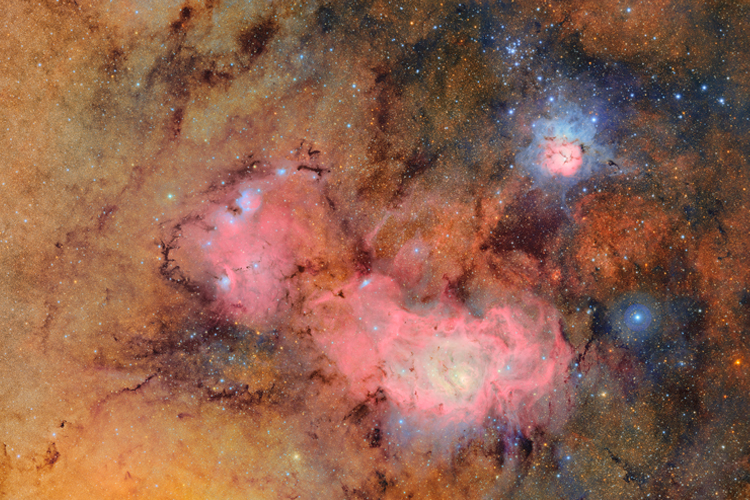On June 23, the Vera C. Rubin Observatory released its first images — vistas captured using the world’s largest camera, mounted on the 8.4-meter Simonyi Survey Telescope on Cerro Pachón in Chile.
The images signal the start of the 10-year Legacy Survey of Space and Time (LSST) which will create an ultra-wide, ultra-high-definition time-lapse sky map of the universe. The survey will be used by astronomers and astrophysicists across the world to study billions of stars, galaxies and solar system objects.
The sensitivity of Rubin will be unparalleled: each night, the observatory will detect 10,000 new objects in the sky. Moreover, after just one year of operations, astronomers expect to discover more asteroids than with all previous telescopes combined.
The Rubin Observatory was named after Professor Vera C. Rubin, a pioneering astronomer whose most significant scientific contribution was her groundbreaking work on dark matter. Her observations were the first convincing evidence of dark matter contributing to the mass of galaxies that we can’t observe directly.
Canada and U of T’s role
The Rubin Observatory is a U.S.-Chile collaboration, with partner nations contributing computational resources, telescope observing time and personnel directly to supporting the scientific infrastructure of the Rubin community, in exchange for the rights to Rubin data.

Canada has secured data rights for Canadian researchers and students through several partnerships, and is building the infrastructure to access and use those data for science. The National Research Council has contributed a data archive and storage facility, while the University of Waterloo and the Faculty of Arts & Science’s Dunlap Institute for Astronomy & Astrophysics have contributed infrastructure personnel, as well as a successful proposal to the Canadian Foundation for Innovation to build the Canadian Data-Intensive Astrophysics PLatform (CanDIAPL).
Several astronomers in the Faculty of Arts & Science have been preparing for data from Rubin and are eager to get their hands on this exquisite data.
Professor Maria Drout, winner of the 2024 Newton Lacy Pierce Prize in Astronomy from the American Astronomical Society, will use the rapid cadence observations of the night sky that Rubin will provide to study cosmic transients and stellar explosions. She works with Canadian Rubin Fellow Tobias Géron to build pipelines for this data within the Rubin Transient and Variable Stars (TVS) collaboration.
Professor Renée Hložek will use the supernova sample from Rubin to study dark energy and its evolution across cosmic time, and leads one of the largest science collaborations within the Rubin community, the Dark Energy Science Collaboration. Hložek, the 2024 recipient of the Rutherford Memorial Medal from the Royal Society of Canada, will be working with Faculty of Arts & Science Fellow Tanveer Karim, who will use Lyman-Break Galaxies to study the evolution of physical models from the infancy of the universe.

Rubin will also discover some of the most distant RR Lyrae stars in the Milky Way Galaxy. Professor Gwendolyn Eadie will use these unique stars to study the outer stellar halo of our galaxy. Eadie, the recipient of the 2024 Dorothy Shoichet Women Faculty in Science Award of Excellence, is jointly appointed between the faculty’s astronomy and statistics departments and will apply her advanced statistical tools to the Rubin data. She is also working with postdoctoral fellow and incoming Schmidt AI in Science Postdoctoral Fellow Kevin McKinnon, who will be using Rubin data in combination with Gaia data to estimate preliminary motions of stars in the outer reaches of the Milky Way Galaxy.
Also a 2023 recipient of the Dorothy Shoichet award, Professor Ting Li will use Rubin’s deep photometry data to search for dwarf galaxies and stellar streams in the Milky Way Galaxy’s halo and the nearby universe, and study the star formation history of dwarf galaxies and the merger history of our own galaxy. Li was recently awarded the 2024 Outstanding Young Researcher Award (OYRA Ardentec Prize) and will be pursuing some of this work with graduate student Nasser Mohammed.
Professor Bob Abraham, chair of the David A. Dunlap Department of Astronomy & Astrophysics, and 2022 Polanyi Prize winner Professor Josh Speagle will use the images from Rubin to investigate how galaxies evolve over time and, building on their expertise with other telescope collaborations such as the Dark Energy Spectroscopic Instrument (DESI) and the Dragonfly telephoto array, will use them to better understand the nature of dark matter and dark energy.
Speagle will work alongside Dunlap fellows Mike Walmsley and Biprateep Dey, who is jointly appointed as a Schmidt AI in Science and also a Canadian Institute for Theoretical Astrophysics fellow, on applying AI methods to understand stars and galaxies, including those found by Rubin. Walmsley is sharing Rubin images with the public on the Zooniverse platform, where volunteers can become citizen scientists and help search for rare galaxies and help calibrate new AI models. Speagle is also a member of Rubin’s Informatics and Statistics Science Collaboration (ISSC).
Professor Michael Reid, a teaching-stream faculty member who is always looking to innovate teaching methods in astronomy has led the design of some of the large astronomy classes at U of T targeted at non-majors which attract students from many disciplines. He will use the many resources produced by the Rubin team to provide opportunities for undergraduate students to get involved in cutting-edge research. Rubin data will enable our students to use U of T telescopes to follow up on transient phenomena in real time.
Read more
Join us for the “first look” at images from Vera C. Rubin Observatory, taken with the largest camera ever built.

